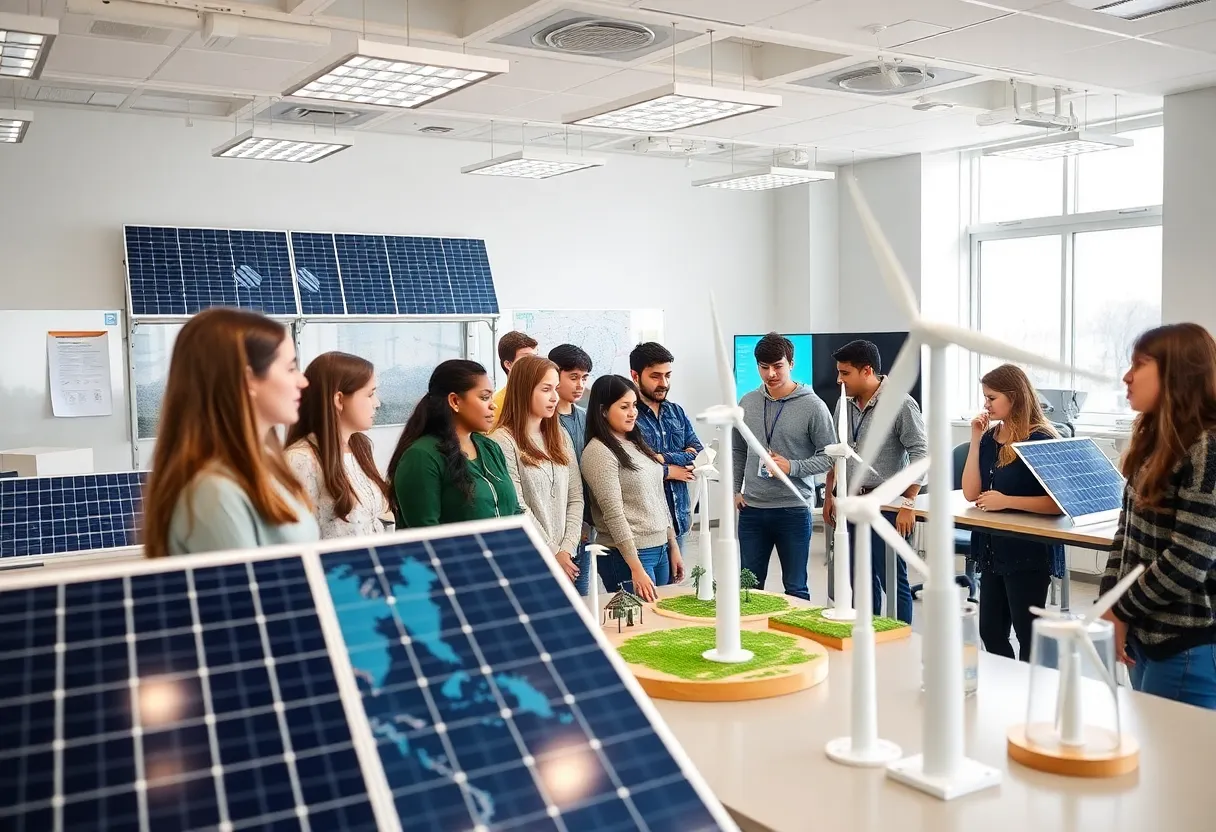Buffalo City, October 15, 2025
Buffalo City Community College has unveiled a new renewable energy lab aimed at training students in solar and wind technologies. Supported by a $500,000 state grant, the facility will prepare around 200 students each year for careers in green energy. The lab features hands-on learning tools and partnerships with regional wind farms, addressing local unemployment and climate change challenges. The initiative has already seen a 30% increase in enrollment for relevant programs.
Buffalo City
Buffalo City Community College has launched a groundbreaking renewable energy lab to equip students with skills in solar and wind technologies. Unveiled on October 15, 2025, this facility marks a significant step in sustainable education within Oklahoma’s rural communities. The lab, supported by a $500,000 state grant, includes advanced simulation software and practical equipment to prepare around 200 students each year for careers in the expanding green energy sector.
Lab’s Core Features and Training Focus
The new lab emphasizes hands-on learning, allowing students to engage directly with renewable energy systems. Key components include simulation tools that model real-world solar panel installations and wind turbine operations. This setup enables trainees to troubleshoot issues, optimize energy output, and understand integration into existing power grids. The facility’s design supports a variety of courses, from introductory renewable energy concepts to advanced certification programs in clean technology maintenance.
By focusing on practical skills, the lab addresses a critical need in Oklahoma’s job market, where demand for qualified technicians in sustainable energy is rising. Students will gain experience with equipment commonly used in commercial settings, bridging the gap between classroom theory and industry application. This approach ensures graduates are ready to contribute immediately to projects that reduce reliance on fossil fuels.
Funding and Community Impact
The $500,000 state grant provided the primary funding for the lab’s development, covering the purchase of specialized equipment and software upgrades. Additional resources came from college budgets allocated for infrastructure improvements. This investment not only builds the facility but also creates opportunities for ongoing maintenance and expansion as technology evolves.
In terms of community impact, the initiative tackles two pressing issues: climate change and local unemployment. Rural Oklahoma faces challenges from environmental shifts and limited job prospects in traditional industries. The lab aims to counter these by training a workforce capable of supporting the state’s transition to cleaner energy sources. Early signs of success include a 30% surge in enrollment for related programs, reflecting enthusiasm from prospective students and the broader community.
Partnerships and Educational Reach
Collaborations with regional wind farms form a cornerstone of the program, offering internship placements that provide real-world exposure. These partnerships allow students to apply lab-acquired knowledge on active sites, such as monitoring turbine performance or assisting with solar array expansions. Such connections strengthen ties between the college and local businesses, fostering a pipeline of talent for Oklahoma’s energy industry.
The lab’s annual capacity to train 200 students positions it as a vital resource for workforce development. Participants come from diverse backgrounds, including recent high school graduates and career changers seeking stable employment in green jobs. Faculty have noted the facility’s potential to inspire innovation, preparing learners for a future where renewable energy plays a central role in economic and environmental sustainability.
Opening Ceremony Highlights
The unveiling event on October 15 drew local leaders and community members, featuring live demonstrations of the lab’s capabilities. Attendees observed simulations of wind energy generation and solar efficiency tests, illustrating the technology’s practical benefits. This public showcase underscored the project’s importance to Buffalo City’s growth, highlighting how educational advancements can drive regional progress.
Broader Context in Sustainable Education
Buffalo City Community College’s effort aligns with wider trends in higher education toward sustainability. Across Oklahoma, institutions are increasingly incorporating green technologies into curricula to meet state goals for renewable energy adoption. This lab elevates the college’s profile, establishing it as a frontrunner in preparing rural students for high-demand fields. The initiative responds to national calls for reduced carbon emissions, while addressing local economic needs through job creation in emerging sectors.
Historically, community colleges like Buffalo City have played key roles in vocational training, adapting to shifts in industry demands. The renewable energy lab continues this tradition, evolving to include cutting-edge topics like energy storage and grid modernization. As Oklahoma’s energy landscape changes—with wind farms dotting the plains and solar potential in sunny regions—the facility ensures local talent remains competitive.
Looking ahead, the lab’s success could influence similar developments at other institutions, promoting a network of sustainable education hubs statewide. For now, it stands as a testament to targeted investment in education, yielding benefits for students, employers, and the environment alike. The 30% enrollment increase suggests sustained interest, potentially leading to expanded offerings in the coming years.
FAQ
When was the renewable energy lab at Buffalo City Community College unveiled?
The lab was unveiled on October 15, 2025.
What technologies does the renewable energy lab focus on?
The lab focuses on solar and wind technologies.
How was the renewable energy lab funded?
The lab was funded by a $500,000 state grant.
What features does the lab include?
The lab features simulation software and hands-on equipment.
How many students will the lab prepare annually?
The lab aims to prepare 200 students annually for green jobs in Oklahoma’s growing energy sector.
What issues does the initiative address?
The initiative addresses climate change and local unemployment.
Are there partnerships involved?
The college has partnerships with regional wind farms for internships.
What is the enrollment trend for related programs?
Early enrollment has surged 30%.
What is the lab’s role in the community?
The lab positions Buffalo City as a leader in sustainable education, fostering innovation and economic growth in rural Oklahoma.
Key Features Chart
| Feature | Description |
|---|---|
| Funding | $500,000 state grant |
| Technologies Trained | Solar and wind technologies |
| Equipment | Simulation software and hands-on equipment |
| Annual Student Capacity | 200 students annually |
| Job Preparation | Green jobs in Oklahoma’s growing energy sector |
| Partnerships | Regional wind farms for internships |
| Enrollment Impact | 30% surge in early enrollment |
| Key Goals | Address climate change and local unemployment |
| Community Role | Leader in sustainable education in rural Oklahoma |
Deeper Dive: News & Info About This Topic
HERE Resources
Buffalo State University Experiences Significant Enrollment Growth
Buffalo City Community College Launches Renewable Energy Training Program
University at Buffalo Launches Net-Zero Energy Initiative
Challenges Loom for Green Energy Development in Buffalo Niagara
Buffalo Sees Major Job Cuts as Companies Announce Layoffs




